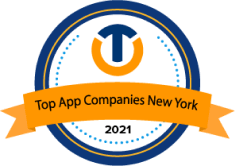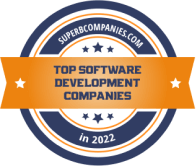How to Leverage AI and Machine Learning in Custom Software Projects
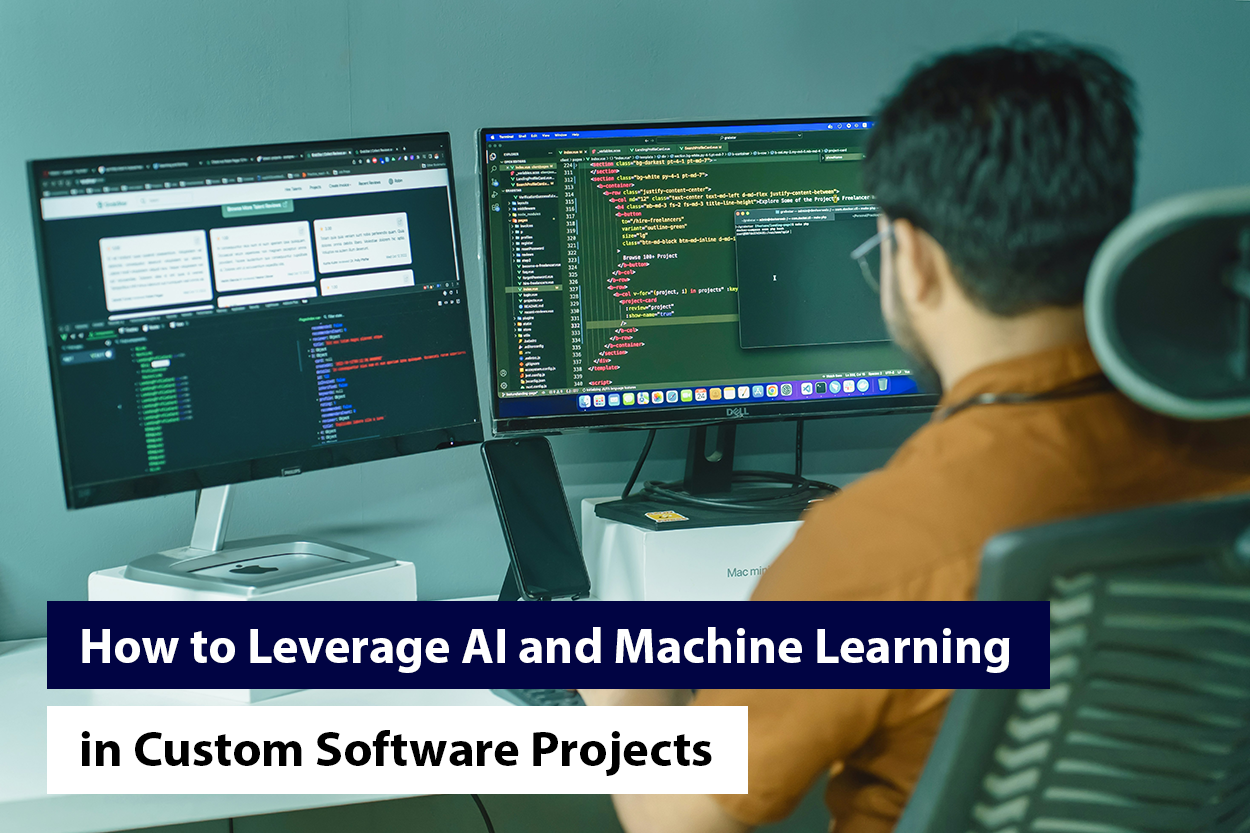
In the competitive business world, innovation is key to success. AI and ML are two technologies that have perpetually altered how businesses function. But is the hype around them justified?
Let’s look at the results of three case studies by Nielsen Norman Group:
- Support agents using AI could handle 13.8% more customer requests per hour.
- Business professionals using AI could write 59% more business documents/hour.
- IT specialists using AI could code 126% more projects every week.
Meanwhile, Harvard Business Review reports that 48% of businesses depend on ML. It allows them to gain deep insights into their customers and prospects.
These results show the key role AI and ML play in boosting operations. This is why this tech stack has gained much attention from software developers. Using them in custom software development is critical to building intelligent products. They enhance the quality and efficiency of every type of solution.
What is AI?
AI (Artificial Intelligence) is a group of technologies. These allow the creation of machines that can simulate functions related to human intelligence. AI-powered machines can see, process, and reply to verbal or spoken language.
AI can analyze data, make suggestions, and do many other things. The tech stack allows a machine to reason, learn, and act to solve any problem.
What is ML?
ML (Machine Learning) is a subset of AI. It allows a machine to learn and improve over time. ML uses algorithms to analyze volumes of data. It learns from insights and makes smart decisions.
ML algorithms improve performance the more exposed they are to data. So, the more data you feed into them, the better model you will get.
How are AI and ML Linked?
AL and ML share a close connection. The points below will help you understand that.
- AI is the broader concept of allowing a machine to sense, reason, act, or adjust like a human.
- ML is an application of AI. It allows a system to gain knowledge from data and learn from it.
AI and ML in Custom Software Development
AI and ML have greatly altered custom software development. They have led developers to go beyond the boundaries of what what possible. Below are all the ways to leverage this tech stack in custom software.
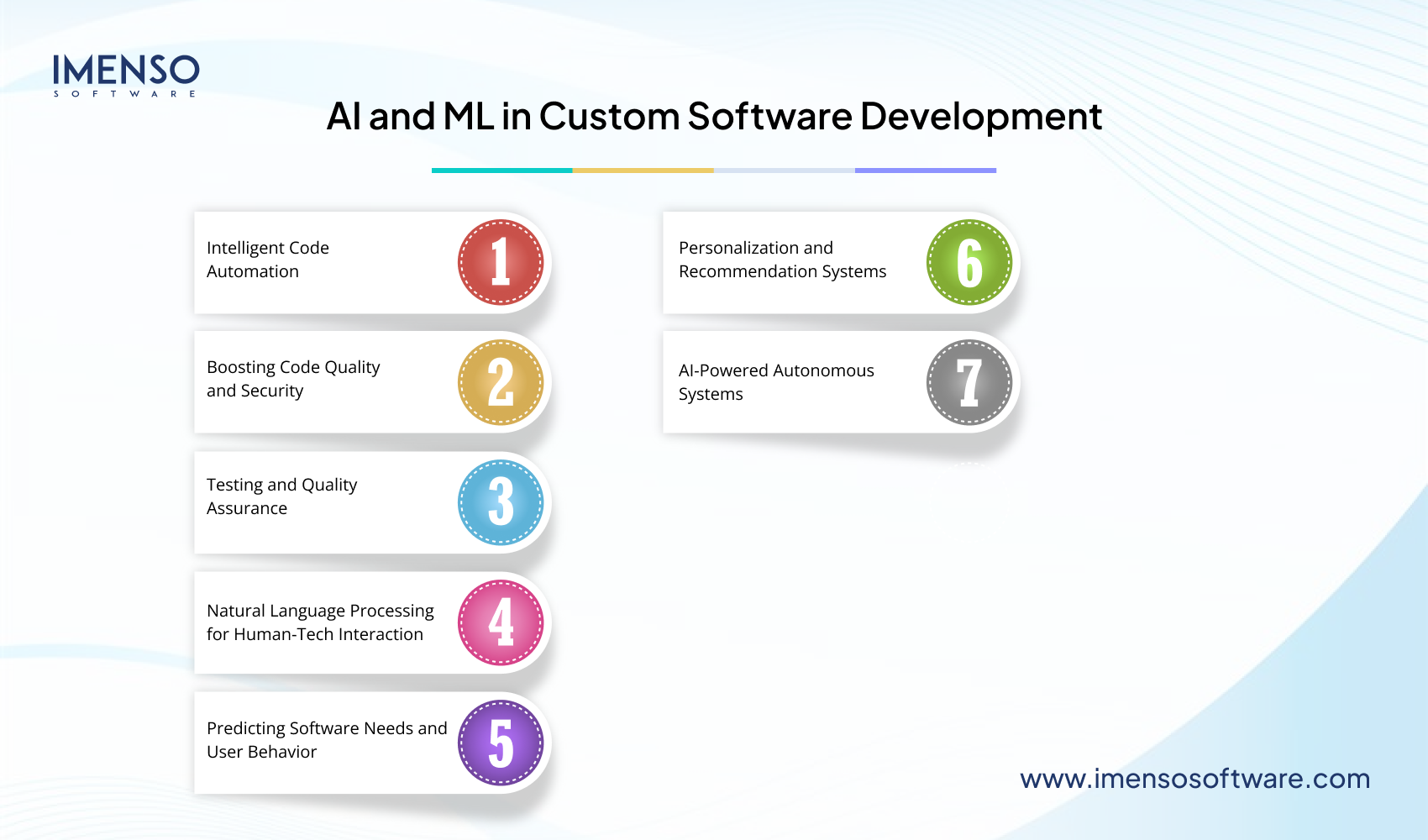
1. Intelligent Code Automation
AL and ML allow for automated code generation. They can create new code snippets. Developers can automate intricate operations. Using AI and ML, developers can improve the quality of their code. This is possible because they can analyze current codebases.
AI and ML thus simplify regular coding processes. They cut the time and effort needed for manual coding. Not only that, but they also improve the code consistency. AI automates repetitive tasks. So, developers can focus on strategic tasks requiring abstract thinking. It thus boosts innovation in software development.
2. Boosting Code Quality and Security
AI and ML allow developers to find patterns in data. They can quickly spot potential errors within codebases. This lets them debug timely. Now, you don’t need to spend your time manually detecting bugs. AI and ML take care of this part. Instead, you can now focus their attention on creativity and problem-solving tasks.
AI and ML algorithms can detect risks before they become serious. This strengthens the software’s security and reliability. It also expedites development.
3. Testing and Quality Assurance
ML is critical in the testing and quality assurance processes. It analyzes test cases and finds potential problems. It also recommends suitable solutions. You don’t need to spend as much time manually testing software. It lets you quicken testing. Besides speeding up testing, it also ensures a more rigorous analysis of the software’s performance.
You can examine patterns with ML algorithms. This lets you fix potential issues and strengthen weak areas. So, AI and ML give you two critical benefits on this front. They let you increase the pace of testing while also improving the software’s quality. All of it lets you give a better user experience.
4. Natural Language Processing for Human-Tech Interaction
NLP is another subset of AI. It allows the software to understand and communicate in human language. Commonly, its use cases are virtual assistants and chatbots. Most modern conversational interfaces use NLP. This technology streamlines communication. It automates customer care tasks. NLP algorithms replicate human-like communication. It analyzes our language patterns and context. This lets it produce suitable responses.
NLP algorithms serve businesses in healthcare and customer service. They are integral for all sectors where communication is critical. By offering relevant replies to customer queries, they help you give a good customer experience.
You can also create customer-centric software with NLP. It is transforming human-tech communication with voice assistants and sentiment analysis tools. NLP algorithms make your communication more personalized.
5. Predicting Software Needs and User Behavior
ML algorithms can analyze user data and market trends. It can anticipate forthcoming software needs and user behaviors. This enables developers to make better decisions. It helps with prioritizing development tasks. You can enhance the software’s features and offer better customer experiences.
Using ML’s predictive insights, it becomes a lot easier to resolve issues timely. Predictive modeling saves time and cost. By anticipating the bottlenecks, you can always remain competitive. It lets you provide software that aligns with the expectations of your end users.
6. Personalization and Recommendation Systems
AI leverages user preferences and behavior. AI systems that function on ML algorithms provide personalized recommendations. They thus enhance user engagement with the content. The tech stack assesses volumes of datasets. Through them, they can predict user preferences. It allows them to offer content and services in real time that are in line with user preferences.
AI and ML-driven apps can understand customers’ needs and interests. This is where their real power lies. This ability allows them to foster deeper connections with end users. The customization made possible with these tech stacks allows people to more meaningfully engage with your software.
7. AI-Powered Autonomous Systems
Today, the pressure to deliver high-quality and secure apps is high. DevOps is a crucial tenet of custom software development. But this model faces challenges as the need for security and speed rises.
AI presents itself as the best solution here. It takes DevOps to another level with autonomous systems. These systems are self-optimizing. They can cut human intervention. This technology ensures that security is in-built at every stage. Thus, it offers measured value and promotes efficiency. Through this, AI autonomous systems drive ROI.
These systems use ML algorithms and predictive analysis. They also use intelligent automation. Autonomous systems can:
Self-Heal
The systems can detect and fix issues automatically. They do not need human assistance.
Self-Optimize
You can ensure optimal utilization of resources with these systems. This is done by regularly monitoring and adjusting the system’s performance. It also ensures optimal response times.
Learn and Evolve
Autonomous systems can adapt to changing situations. They analyze past data to improve over time. Through data analysis, they can offer real-time insights.
“I believe AI is going to change the world more than anything in the history of humanity. More than electricity.”
– Kai-Fu Lee, AI Expert, Chairman & CEO of Sinovation Ventures, Author of ‘AI Superpowers’ and ‘AI 2041’
How to Apply AI and ML in Your Custom Software for the Greatest Impact
To drive the most impact with AL and ML, follow these best practices.
Analyze Your Product Goals
Assess the goals of your project. What is it that needs a resolution? Commonly, for startups, scaling the product is a big hurdle. Find which areas are lagging due to process inefficiencies. It is here that you can use automation and predictive analysis.
Get Adequate Data to Train Models
High-quality datasets are critical for your project’s success. So, check if you have enough data to train AI/ML models. Also, look for domains where spotting patterns and trends can lead to dramatic improvements. These can be areas like operational optimization and user behavior prediction.
Discover the Pain Points of Your Stakeholders
Interact with your stakeholders. Find out their pain points and challenges. This will help you find out specific needs for better solutions. You can impart a better user experience. As an example, in retail, you can use AI/ML algorithms to automate inventory management. This can lower excess stock levels by more than 10%.
Conduct a Competitor Analysis
Look at your competition. Find out how they are using AI and ML in software development. Successful companies use advanced analytics to gain an edge over others. You can leverage the same in your project. This will help you discover areas where your software can solve the issues faced by your target market.
Launch a Prototype
Creating a prototype lets you check if your product idea holds up. If the response is good, go ahead and implement it. But if not, it will prevent a waste of time and money. If your stakeholders like the prototype, they will become confident in it. Thus, it will become easy for you to secure an investment.
Review Your Performance
Regularly track your performance throughout development. Over 30% of projects fail without periodic performance tracking. Reviewing your performance will help you find out your weaknesses and strengths. You can adjust your project goals accordingly. Create KPIs tied to your project goals. This ensures you benefit from measurable success.
How to Choose the Right AI/ML Algorithm for Custom Software?
Choosing the right AI-ML algorithm is crucial to your software’s success. Below are the various types of algorithms to help you decide better.
Supervised Learning Algorithms
These algorithms learn patterns. They predict based on the training data. These algorithms use input features and related output labels. On their basis, they can make accurate predictions on new data.
The models can handle regression and classification tasks. Regression tasks entail predicting a continuous value. An example is predicting house prices based on certain features. Classification tasks assign instances to predefined classes. A use case can be sorting emails as spam or non-spam.
There are various kinds of supervised learning algorithms. Each has its pros and cons depending on your problem. Some real-life examples where these algorithms are used are:
- Price forecasting
- Language translation
- Filtering spam
- Face detection
- Image classification
- Speech recognition
Unsupervised Learning Algorithms
These algorithms analyze and extract patterns from unlabeled data. They can do this without any human action. These models can find hidden linkages within data. By identifying them, they offer precious insights. Thus, unsupervised learning algorithms let you make sense out of abstract datasets.
They work for various industries. Some types include anomaly detection and customer segmentation. They give you new knowledge so you can carve your distinct edge. Below are the areas where you can use them.
- Customer segmentation
- Computer vision
- Product Segmentation
- Personalized recommendation systems
- News sections
Semi-Supervised Learning Algorithms
These close the gap between the first two algorithms. They can leverage labeled and unlabeled data. So, they can learn effectively from limited labeled examples. In doing so, they use volumes of unlabeled data that are present. This approach leads to scalable and inexpensive solutions.
Semi-supervised algorithms can generalize accurately based on the new data. This is because they use information offered by unlabeled data. It allows them to spot hidden patterns. These are not visible when you rely on labeled examples alone. These algorithms make tasks like fraud detection and sentiment analysis more efficient.
You can apply these algorithms in the following use cases:
- Classification of web content
- Finding the 3-D structure of a protein
- Identifying the presence of oil at a specific location
- Speech recognition
Reinforcement Learning Algorithms
These algorithms allow machines to decide intelligently. It learns from user conversations. The algorithms work on a core concept. It involves an agent communicating with the environment. It gets feedback in two forms. First is the rewards, and the other is the penalties for what it does. Over time, the agent enhances its reward score. This iterative process lets machines adjust and enhance their decision-making.
There are several use cases of reinforcement learning. Most noteworthy among them is the field of robotics. Here, these algorithms allow autonomous systems to navigate complex settings. They can even gain new skills with trial and error. In finance, it optimizes investment strategies based on market trends. Thus, it aids with portfolio management.
Do You Know?
IBM’s Watson platform uses ML algorithms for predictive analytics in software development. By assessing data from various software projects, Watson can spot patterns causing project failures. This insight enables it to prevent risks. For instance, Watson is repeatedly used to predict the possibility of software defects based on past data. It thus promotes proactive testing and quality assurance initiatives.
Factors to Consider When Selecting the Right AI-ML Algorithm
You must consider various factors when choosing an algorithm. Below are three critical ones.
Availability and Quality of Data
Without adequate data, the algorithm cannot deliver accurate outcomes. You must also ensure that the data in question is relevant. So, examine if your dataset fills the needs of the algorithm you choose.
Performance and Scalability
The algorithm must be capable of handling huge volumes of data efficiently. It should be able to do so without any compromise in accuracy. The model must be able to scale based on the growth of your data.
Domain Expertise
Different algorithms work for specific industries. So, you must have a good grasp of the sector and the target market. It will help you choose an algorithm that lets you develop novel software for your domain. You are likely to get better results from an algorithm designed for your domain.
4 Must-Have AI and ML Features for Custom Software Development
AI and ML are reshaping custom software development practices. Software teams should incorporate these features to build intelligent apps.
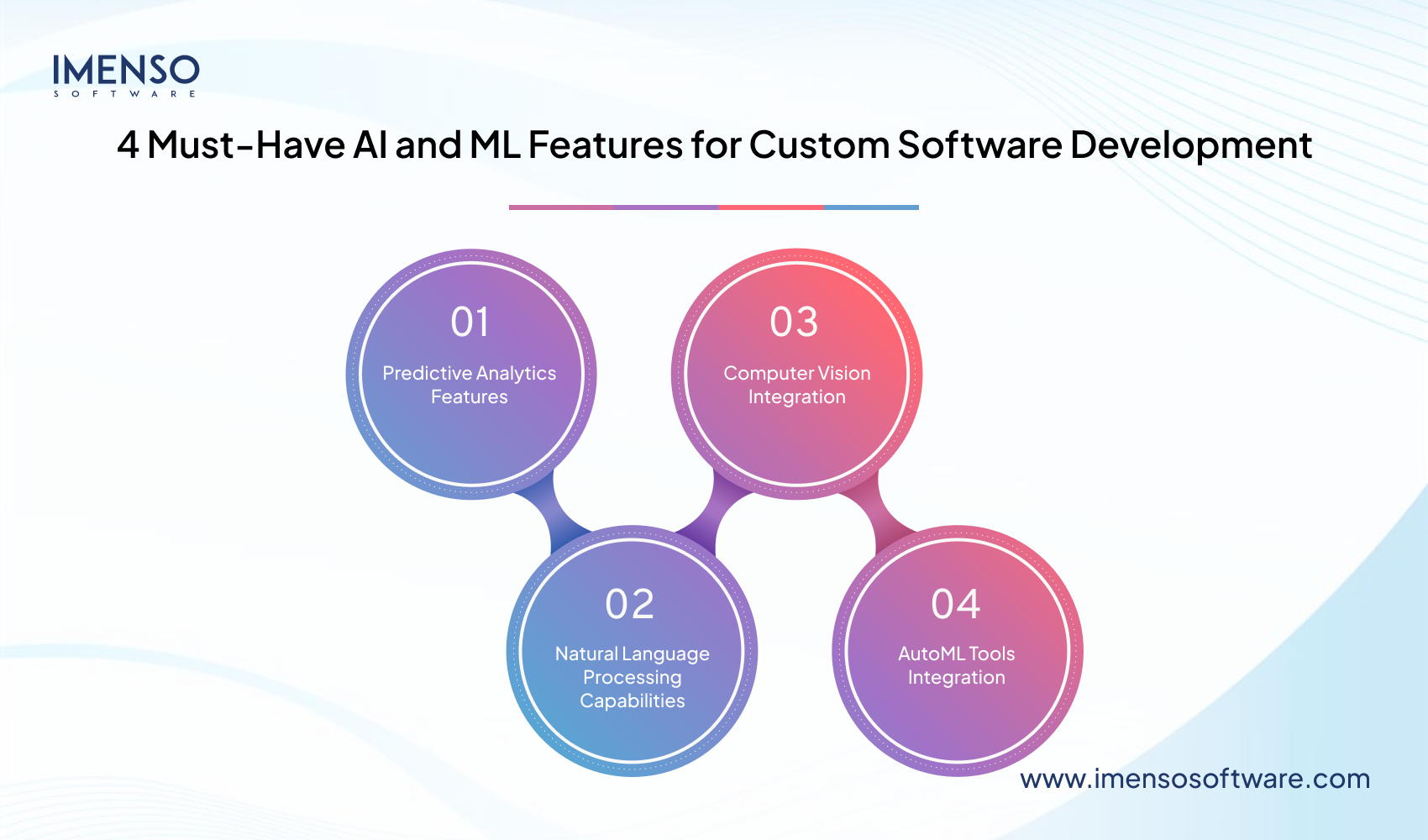
1. Predictive Analytics Features
Predictive analytics is the next generation of data-driven software creation. Statistical algorithms and ML models analyze past patterns to accurately predict future outcomes.
You can implement these capabilities with these approaches:
Data Pattern Recognition
Advanced models find hidden trends within huge datasets. This leads to data-led decision-making.
User Experience Optimization
Behavioral analysis makes way for personalized interactions. Its best example is Netflix with its content recommendations that drive engagement.
Preventive Maintenance
Early anomaly detection lets teams anticipate issues before they become serious.
Resource Planning
Accurate forecasting leads to better resource allocation.
Risk Analysis
Past data analysis uncovers potential threats. This lets you manage risk proactively.
2. Natural Language Processing Capabilities
NLP allows software to process human language accurately. This makes way for personalized user interactions. It is also used for automated text analysis.
Below are key NLP applications:
Sentiment Analysis
Text assessment reveals emotional context in client feedback.
Topic Identification
Automated content categorization simplifies information management.
Language Recognition
Multi-language support permits global deployment.
Key Information Extraction
Smart summarization boosts content accessibility.
Document Classification
Automated classification enhances information retrieval.
3. Computer Vision Integration
Computer vision programs interpret visual data. It allows the software to process images and video streams intelligently.
Primary use cases include:
Visual Recognition
Automated object and scene recognition for content moderation and quality control.
Object Tracking
Real-time detection fuels autonomous systems and security software.
Document Processing
OCR technology turns pictures into searchable text.
Medical Imaging
The advanced analysis aids diagnostic procedures.
4. AutoML Tools Integration
AutoML platforms make ML implementation accessible to all. They allow software teams to embed AI features without much ML expertise. The chief benefits of AutoML tools are
Key benefits are:
- It gives AI access to more teams so they can implement ML solutions.
- The pace of development increases. Automated processes lower deployment time.
- Systematic optimization improves model quality.
- Automation enhances the team’s efficiency. They can work on more complex tasks.
Embracing AI and ML in Software Development
AI and ML are changing the very fabric of software development. They bring a wealth of benefits that developers can use responsibly. By automating redundant processes and simplifying testing, this tech stack greatly increases development efficiency. It’s never too late to use them in your software projects. A thoughtful usage of these technologies will pave the way for innovation and quality in all your projects.
Frequently Asked Questions
-
- 1. How do you integrate AI into your software?
Define the AI use case. Then, create an AI strategy keeping user experience in mind. Build a prototype of your product and test it. Fix issues and deploy.
-
- 2. Can we do AI and ML together?
Yes, you can use both AI and ML in software development. AI solutions often use ML algorithms to learn from data and make accurate predictions. Modern software has both AI and ML built-in capabilities.
-
- 3. What is the best language for ML and AI?
Python is the best language for AI and ML. It’s readable and versatile. Python also has many libraries. The language is easy to use and is widely used for AI and ML projects.
-
- 4. Can AI exist without ML?
Yes, AI can exist without ML. In the past, it has existed without ML. ML is a subset of AI. It is not the only way to build intelligent machines. Symbolic AI and expert systems are two forms of AI without ML.
Want more information about our services?
Similar Posts

A Foolproof Guide to Successfully Uploading Your App to Play Store & App Store
Have you ever wondered how to turn your brilliant app idea into a reality on the app stores? If this question has been lingering in your thoughts, you’re about to discover the key. Welcome to the world of app submission – a pivotal phase that often appears as a complex puzzle. Fortunately, our comprehensive guide […]...

12 Best Practices to Secure Your API in the AWS Cloud
Have you ever wondered how much of our digital world operates seamlessly behind the scenes? From mobile banking to social media integration, Application Programming Interfaces (APIs) serve as the backbone of modern technology, facilitating the smooth exchange of data and communication between diverse systems. However, as APIs continue to proliferate, so do the threats to […]...

Unlocking Offshore Development Insights Of India In 2024
Wondering how tech giants survive in this competitive era keeping an eye on cost-cutting and high-level solutions? Yes, the answer is offshore development, where countries like India are filled with excellence, creativity, and cost-effectiveness. Also, are you aware that India acquires approximately 55% of the global market share in offshore services, making it a dominant […]...




